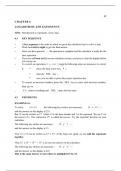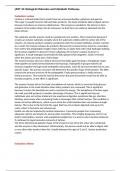📰
Newspapers- Set texts= The
Guardian and The Daily Mail
Media Language, Representation, industries,Audiences
and Contexts
Media Representations - Theories
Representation= How the media portray events, issues, individuals and social
groups
Representations offer a version of reality
Representations are subjective rather than objective and are constructed. They are
always from a particular perspective (on the world $)
Theories of Representation:
Stuart Hall= Stereotypes and Dominant ideologies
Media representations reinforce and construct stereotypes which reflect inequalities in
power
Representations in texts are established through media language
Media representations are often reliant upon stereotypes which reduce social groups to
simplistic characteristics or traits
These stereotypes reflect inequalities in power leading to the subordination of certain
social groups eg ethnic minorities and women
David Gauntlett= Identity
Modern Media such as social media offers audiences the tools to construct alternative
representations that challenge traditional stereotypes
Liesbet Van Zoonen = Patriarchy
Newspapers- Set texts= The Guardian and The Daily Mail 1
, Representations of gender in the media reflect a patriarchal- male dominated society
Gender is constructed through media language and these constructions reflect cultural
and historical contexts
The objectification of the female body is a key construct of western culture
The visual and narrative codes- media languages used to represent the male body
differ- reflecting patriarchal society
Judith Butler= Gender Performativity
Representations of gender in the media are based upon and assumption of how men
and women should perform based on their sex
Bell- Hooks= Intersectionality
Inequalities based upon race and class reinforce patriarchal representations in the
media
Paul Gilroy = Post Colonialism
Representations of race in the media reflect attitudes from the colonial era
https://www.youtube.com/watch?v
=GzAJCoU9dLk
Media Language - Theories
Theories of Media Language :
Roland Barthes= Semiotics
Meanings in media texts are constructed through a process of signification which
creates both denotative and connotative meanings. Meanings become myths where
connotative meanings become dominant and are perceived as literal
Media products communicate a complex series of meanings to their audiences through
a range of visual codes and technical codes. These codes can broadly be divided in to
proairetic, symbolic, hermeneutic, referential, and so on.
Newspapers- Set texts= The Guardian and The Daily Mail 2
, After many years of codes being repeated, their meaning can become generally agreed
upon by society. For example, a scar on the face of a character can function as a
hermeneutic code, indicating to the audience that they are ‘the villain’.
After many years of codes being repeated, their meaning can become generally agreed
upon by society. For example, a scar on the face of a character can function as a
hermeneutic code, indicating to the audience that they are ‘the villain’.
Barthes also considered the importance of
myths
Myths are stories and legends, which are passed down from generation to generation.
They teach us why the world is the way it is, and also offer clues and instructions on
how we behave. For example, in Greek myth of Narcissus, Narcissus was a particularly
beautiful young man who turned down every woman as they didn't live up to his
expectations. After he ignored Echo for so long, she faded away in to nothing, and
became just a voice in the breeze. This is where echoes come from. Narcissus was
punished, and was led to fall in love with his own reflection. When he realised that he
could consummate his love with himself, he killed himself. This myth warns the listener
to not be so self-obsessed, and it is even where we get the term 'narcissist' from
For Barthes, the myths of modern society can be found in media products. Whereas
previously we would learn from legends, now we are more likely to discover social
norms and values from advertising. For Barthes, a myth is a widely held belief which is
reinforced and exceed through media language. This concept is closely related
to hegemony and stereotypes.
https://www.youtube.com/watch?v
=bow0Y9QUlBU
Tzevetan Todorov= Narratology
Meaning in media texts rely on either a literal or suggested movement from a state of
one equilibrium to another, separated by a period of imbalance or equilibrium
Todorov's theory of narrative equilibrium is based around a three act structure. Firstly, a
state of balance or equilibrium is established. This balance is disrupted or broken in
Newspapers- Set texts= The Guardian and The Daily Mail 3
Newspapers- Set texts= The
Guardian and The Daily Mail
Media Language, Representation, industries,Audiences
and Contexts
Media Representations - Theories
Representation= How the media portray events, issues, individuals and social
groups
Representations offer a version of reality
Representations are subjective rather than objective and are constructed. They are
always from a particular perspective (on the world $)
Theories of Representation:
Stuart Hall= Stereotypes and Dominant ideologies
Media representations reinforce and construct stereotypes which reflect inequalities in
power
Representations in texts are established through media language
Media representations are often reliant upon stereotypes which reduce social groups to
simplistic characteristics or traits
These stereotypes reflect inequalities in power leading to the subordination of certain
social groups eg ethnic minorities and women
David Gauntlett= Identity
Modern Media such as social media offers audiences the tools to construct alternative
representations that challenge traditional stereotypes
Liesbet Van Zoonen = Patriarchy
Newspapers- Set texts= The Guardian and The Daily Mail 1
, Representations of gender in the media reflect a patriarchal- male dominated society
Gender is constructed through media language and these constructions reflect cultural
and historical contexts
The objectification of the female body is a key construct of western culture
The visual and narrative codes- media languages used to represent the male body
differ- reflecting patriarchal society
Judith Butler= Gender Performativity
Representations of gender in the media are based upon and assumption of how men
and women should perform based on their sex
Bell- Hooks= Intersectionality
Inequalities based upon race and class reinforce patriarchal representations in the
media
Paul Gilroy = Post Colonialism
Representations of race in the media reflect attitudes from the colonial era
https://www.youtube.com/watch?v
=GzAJCoU9dLk
Media Language - Theories
Theories of Media Language :
Roland Barthes= Semiotics
Meanings in media texts are constructed through a process of signification which
creates both denotative and connotative meanings. Meanings become myths where
connotative meanings become dominant and are perceived as literal
Media products communicate a complex series of meanings to their audiences through
a range of visual codes and technical codes. These codes can broadly be divided in to
proairetic, symbolic, hermeneutic, referential, and so on.
Newspapers- Set texts= The Guardian and The Daily Mail 2
, After many years of codes being repeated, their meaning can become generally agreed
upon by society. For example, a scar on the face of a character can function as a
hermeneutic code, indicating to the audience that they are ‘the villain’.
After many years of codes being repeated, their meaning can become generally agreed
upon by society. For example, a scar on the face of a character can function as a
hermeneutic code, indicating to the audience that they are ‘the villain’.
Barthes also considered the importance of
myths
Myths are stories and legends, which are passed down from generation to generation.
They teach us why the world is the way it is, and also offer clues and instructions on
how we behave. For example, in Greek myth of Narcissus, Narcissus was a particularly
beautiful young man who turned down every woman as they didn't live up to his
expectations. After he ignored Echo for so long, she faded away in to nothing, and
became just a voice in the breeze. This is where echoes come from. Narcissus was
punished, and was led to fall in love with his own reflection. When he realised that he
could consummate his love with himself, he killed himself. This myth warns the listener
to not be so self-obsessed, and it is even where we get the term 'narcissist' from
For Barthes, the myths of modern society can be found in media products. Whereas
previously we would learn from legends, now we are more likely to discover social
norms and values from advertising. For Barthes, a myth is a widely held belief which is
reinforced and exceed through media language. This concept is closely related
to hegemony and stereotypes.
https://www.youtube.com/watch?v
=bow0Y9QUlBU
Tzevetan Todorov= Narratology
Meaning in media texts rely on either a literal or suggested movement from a state of
one equilibrium to another, separated by a period of imbalance or equilibrium
Todorov's theory of narrative equilibrium is based around a three act structure. Firstly, a
state of balance or equilibrium is established. This balance is disrupted or broken in
Newspapers- Set texts= The Guardian and The Daily Mail 3










